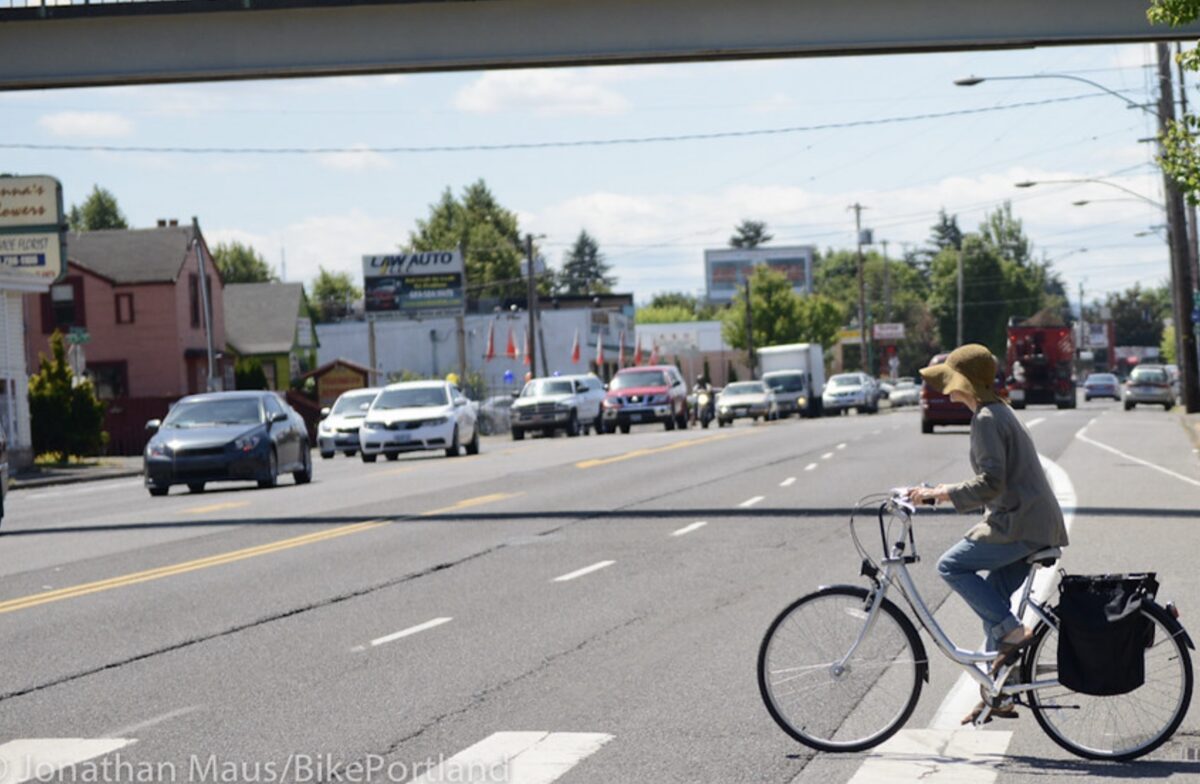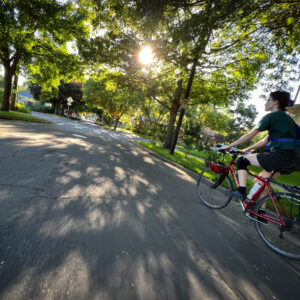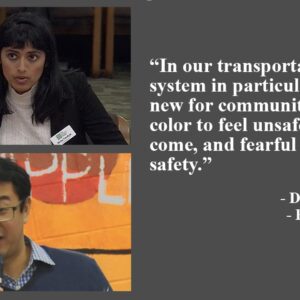As the impacts of climate change have stomped into Portland, it’s becoming very clear that east Portland bears the brunt. Because there are fewer parks, fewer trees, and more roads and other paved surfaces, our (now) annual heat waves scorch that part of our city.
Back in June, environmental nonprofit organization 350 PDX hosted a bike ride in east Portland to highlight the need for climate resiliency and the value of shade. When it comes to beating back a warming planet, green infrastructure is one of our greatest weapons.
Now there’s a really cool opportunity to work on-the-ground to bring more of that to east Portland.
The Asian Pacific American Network of Oregon (APANO) is looking for three people to serve as Greening Ambassadors. Richa Poudyal, an independent consultant who is helping APANO launch the program, told us this morning that, “The program is a chance for east Portlanders to create and implement climate resilient solutions for their own neighborhoods instead of perpetually waiting and relying on government institutions.”
Applicants must live east of 82nd Avenue, and be 14 years of age or older. If selected, ambassadors will work with APANO to organize a block party and a tree planting event this summer. Ambassadors will also work with APANO to flesh out their vision for what a green block will look like — and then figure out how to actually implement it.
The program will train ambassadors to be climate justice organizers, pay a $600 stipend, and provide $8,000 for each participant to spend on block-greening projects.
Deadline to apply is April 15th and the job is from May to December of this year.
You can apply online here.








Thanks for reading.
BikePortland has served this community with independent community journalism since 2005. We rely on subscriptions from readers like you to survive. Your financial support is vital in keeping this valuable resource alive and well.
Please subscribe today to strengthen and expand our work.
It would be awesome to get more trees (or anything green) planted at the old Fred Meyers parking lot at 82nd & Foster, one of the highest temperature spots in SE in the summertime. It is never more than half full, plenty of surplus pavement to be ripped up.
The headline clearly says “greening ambassadors,” yet I thought it said “greenwashing ambassadors.” I had to read it several times before I got it right.
“Greenwashing ambassadors” may be more accurate.
Greenwashing is when a company or organization does superficial (or insufficient) environmentally friendly performative things to distract from their otherwise bad image.
A non-profit like this just trying to help people isn’t greenwashing. There is no need to be so cynical about such a simple good idea.
I see your point but I’m now dubious about any nonprofit in Portland that is taxpayer funded. It seems their goals then become to continue the problems they profess to help solve so they can advocate for even more taxpayer money to be sent their way. The outsourcing of governmental functions to unaccountable nonprofits is NOT serving us well.
Oh yeah, I too am skeptical of the effectiveness of non-profits to do anything. Similar to a business, I think their goal becomes maintaining themselves. They might be capable of doing good and some do, but yeah it would be better to have a more accountable organization do this work. I only think calling this greenwashing feeds into a narrative that any kind of tree planting and things like this article mentions is nothing more than performative. I think we do need trees planted and they seem to be trying to do it.
I’m totally behind more trees being planted— just can’t get behind it being done by APANO. APANO (in my opinion) is more of a political activist group than a traditional nonprofit. The really discouraging thing is the one government funded nonprofit that I trusted (Friends of Trees) had their funding ELIMINATED by the City of Portland. Argh!
https://friendsoftrees.org/
Friends of Trees is great and effective, and no one at the city would give me a straight answer about why their funding was cut.
Despite all the hand-wringing, Portland seems to have given up on trees.
Not big on how they have gone about this tree panting In my neighborhood. They came in and planted in the strip between the sidewalk and curb. Horrible place to plant.
1. Causes heaving of sidewalk, which is the homeowners responsibility to repair.
2.Same issue with the adjoining bike path making it unrideable.
3.Choice of nut bearing trees meaning more flats on the bike path.
4.Nothing like trying to ride in the fall on a bike path covered in wet leaves.
5.Planting directly below power lines, adding to the cost of maintenance, not to mention the horrible combination of wind, trees and power lines. Did we learn nothing from PG&E?
I’ve had various organizations come around my neighborhood peddling trees that just don’t work next to sidewalks (like the many issues you mention) and I just laugh at them and tell them I wouldn’t trust them to plant a tree on my property at all. I loved the one that just couldn’t believe I was turning away a “free” tree from them.
As full disclosure nonprofit APANO director Duncan Hwang, has been accused of questionable ethics. Unfortunately, this is not uncommon in Portland.
https://www.wweek.com/news/2022/05/04/two-metro-councilors-employers-get-money-from-metro-a-candidate-cries-foul/
Living in one of the farther out east side neighborhoods I’m pretty excited about more trees being planted. There’s a big difference in how the neighborhoods feel as you get closer to the willamette, that in my mind is largely from the nice street trees in the older neighborhoods.
Would be interesting to have some data on per capita carbon emissions of the east and west side.
I suspect the overall emissions are considerably less on the east side.
I remember seeing a Multnomah County health report from a few years ago that had substantial emissions components – they were looking at health impacts of various types of pollution – and as you would expect, the main areas of air and noise pollution were along freeway corridors. Apparently both the county and state agencies have numerous pollution monitoring devices all over the place. The source of the pollution isn’t necessarily local residents, but more often people passing through from other counties and states.
I’d love to see some numbers before & after the road diet along Foster. I wouldn’t be surprised if it’s worse now with the solid gridlock from 50th to 205 in the afternoon. It’s funny how much attention is given here to pollution for kids in the rosa parks school building 8 hours a day, 9 months a year, but nothing was ever said for us working class people who live right along Foster all day, every day. I wonder how much extra poison my toddler has inhaled these past 5 years when we played outside.
Not disagreeing, but I expect that living near major roadways like Foster is going to get better as we transition to electric vehicles. Pollution will improve (despite a marginal increase in PMs from tire wear), and noise will be reduced. And there will be less oil and coolants leaking everywhere.
Not downplaying the hazards, but there is some relief on the horizon.
The road diet has meant fewer cars traversing Foster in the PM peak. Has this been enough to offset the increased emissions from idling vehicles? Let’s find out.
In 2013, about 1,000 cars traversed Foster between 82nd and 205 in the PM peak hour (count ID 13051323.VL1 here). In 2019 (post road diet) it was 650 or so (count ID 19080182.VL1). So reducing the total vehicle miles on the 2.5 mile stretch of road here by 875 in the peak hour. Given the average fuel economy of a car is in the 25 mpg range, this means about 35 gallons of gas saved by the vehicle mile reduction in the peak hour.
An idling vehicle burns about 1/5 of a gallon of gas in an hour, and it’s about a 7 minute drive between 50th and 205 on Foster with no traffic. Google says that the worst time currently on a typical weekday is 18 minutes. If 100% of the delay time is idling (which it’s not), then those 650 cars spending an extra 11 minutes would burn about 24 gallons of gas due to the delay.
So even if you assume that there was 0 time delay pre-road diet (which there wasn’t) and that 100% of the current time delay is wasted due to cars idling (it’s not), there are still fewer gallons of gas being burned now than there were pre-road diet.
I’d be interested to know where those “missing” vehicles went. I’m sure some folks think the drivers simply stayed at home, but I’d like a data-based answer. If they took longer but less congested routes, or wove their way through the surrounding neighborhoods, that might not be such a win.
It’s unlikely that the long-term effect is weaving through neighborhoods, especially on a diagonal route like Foster. I would think that Powell would be the route of choice between 50th and 205 for southbound 205 drivers now, not exactly scientific I guess. But if you look at Google maps suggested routes in the PM peak from say 49th and Powell to a random point south of Foster on 205, in non-congested times it will recommend Foster but it will go for Powell once 4:15 or so rolls around. There isn’t any recommendation for weaving (which isn’t to say cut-through traffic doesn’t happen – just that Google doesn’t think it’s faster). Considering that Google’s traffic is roughly just an aggregation of actual trips, it’s instructive to use it still I think even if it’s not exactly perfect.
I think it’s quite difficult to say exactly what happened without asking people specifically. There are so many factors that determine travel behaviors. Travel demand modeling is already pretty inexact, and even more so if you are trying to understand the effects on one particular street.
A lot of drivers from Powell are now weaving their way through the neighborhood north of Powell trying to get around the congestion. The balloon has been squeezed.
Another reason freeways through the middle of city centers was one of the most short sighted (or nefarious) ideas ever devised. Freeways don’t belong in cities.
Agreed. But it’s a rare city that doesn’t have them – With 615,000 residents, Winnipeg is the biggest US or Canadian city I can think of off-hand without a freeway, unless you count Victoria BC as a “city”. Even metro Vancouver BC has several, in Delta, New Westminster, North Vancouver, and so on.
If you were to list off every major Canadian city by freeway lane-miles, only Toronto would even sniff like a typical US city. The US and Canada have almost categorically different freeway typologies.
I can think of maybe 2 total expressways in Canada that were built through dense urban environments (the Gardiner Expressway in Toronto and Route 15 in Montreal). There are countless examples in the US. Like literally more than I could count. There are two in Portland alone!
Here is a list of major world cities without a “downtown freeway route” that was built through a dense urban core: Rome, Paris, London, Berlin, Munich, Frankfurt, Vancouver, Guadalajara, Bogota, Amsterdam, Copenhagen, Moscow, Helsinki, La Paz, Havana, Delhi, Dublin, Liverpool, Birmingham, Cairo, Istanbul, Accra, Addis Ababa, Montevideo, Tehran, Warsaw, Asuncion, Budapest, Saint Petersburg. The US is fairly unique by world standards in terms of having built massive amounts of car infrastructure through the downtown cores.
The $600 stipend shows how much APANO values its organizers.
Most of the taxpayer money they receive goes to staff overhead I’m afraid. Government “services” via unaccountable nonprofits is a MAJOR problem in Portland and Multnomah County. For example the last 990 one can find on APANO is from 2019 and it’s impossible to tell how much of their $3.49 MILLION in revenue was from taxpayers.
https://apps.irs.gov/pub/epostcard/cor/800252850_202006_990_2021052018154292.pdf
For what it’s worth (not much), APANO is both a 501c3 charity for tax deductions and a 501c4 for lobbying and administration (no tax deductions – a PAC). Nonprofits that like to get a variety of different donors tend to public an annual report outlining what they do, mission, and so on, plus who they get funding from. However, it is not legally required by any organization to do so, but it is required to file a federal 990 at least every 3 years (if they file for 2021 they’ll still be in compliance) and to file various state forms. If you want more details on APANO, I’d start by contacting the Oregon Department of State online and looking up nonprofits.